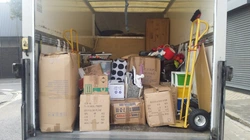Removals in Office Removals: A Comprehensive Guide to Smooth Transitions

Relocating an office can be a daunting task, laden with countless details that need meticulous planning and execution. Whether you're moving to a larger space to accommodate a growing team or downsizing to optimize operational costs, understanding the nuances of office removals is crucial for a seamless transition.
Office removals go beyond simply transporting furniture and equipment; they involve strategic coordination to minimize downtime and ensure business continuity. From selecting the right removal company to organizing the layout of your new space, each step plays a vital role in the success of your move.
In this guide, we'll delve into the essential aspects of office removals, providing you with actionable insights to make your move efficient and stress-free.
The Importance of Professional Office Removal Services

Hiring professional office removal services can make a significant difference in the outcome of your relocation. These experts bring specialized skills and equipment to handle the unique challenges associated with moving an office environment.
Professional movers ensure that your office items are packed securely, transported safely, and unpacked efficiently in your new location. They also offer additional services such as packing, labeling, and even setting up your workspace, allowing you to focus on your core business activities during the transition.
Moreover, experienced removal companies are well-versed in logistics planning, helping you to schedule the move at a time that minimizes disruption to your operations.
Planning Your Office Move

Assessing Your Needs
Before initiating the move, it's essential to assess your office's specific requirements. This involves taking stock of all the items that need to be relocated, including furniture, electronics, and sensitive equipment.
Consider the layout of your new office space and how it will accommodate your current and future needs. This assessment will help you determine the resources required for the move, such as the number of movers, packing materials, and transportation vehicles.
Additionally, evaluating any special requirements, such as handling of delicate equipment or compliance with industry regulations, is crucial to ensure a smooth relocation process.
Creating a Moving Timeline
Developing a comprehensive moving timeline is an integral part of the planning process. This timeline should outline all the tasks that need to be completed, from notifying stakeholders and updating your address to scheduling the removal date and setting up utilities in the new office.
It's advisable to start planning several months in advance to allow ample time for each phase of the move. Breaking down the timeline into manageable steps can help prevent last-minute rushes and reduce the likelihood of oversight.
Ensure that all team members are aware of the timeline and their respective responsibilities to promote collaboration and efficiency throughout the move.
Choosing the Right Office Removal Company

Factors to Consider
Selecting a reputable office removal company is paramount to the success of your move. Here are key factors to consider:
- Experience: Look for companies with a proven track record in handling office relocations.
- Services Offered: Ensure they provide a comprehensive range of services, including packing, transportation, and setup.
- Insurance: Verify that the company offers adequate insurance coverage for your belongings.
- Customer Reviews: Check testimonials and reviews to gauge customer satisfaction.
- Cost: Obtain detailed quotes and compare pricing structures to find a service that fits your budget.
Requesting Quotations
When requesting quotations from removal companies, provide detailed information about your office space, the volume of items to be moved, and any specific requirements. This will enable companies to give accurate estimates and propose tailored solutions that meet your needs.
Compare the quotations not just based on price, but also on the services included and the company's reputation. Remember that the cheapest option may not always offer the best value.
Engage in discussions with potential movers to clarify any doubts and assess their professionalism and responsiveness.
Packing and Organizing for the Move

Packing is a critical component of any office move. Proper packing ensures that your items are protected during transit and facilitates an organized setup in your new space.
Begin by categorizing your items based on their relevance and frequency of use. Essential items needed immediately after the move should be packed separately for quick access.
Invest in high-quality packing materials, such as sturdy boxes, bubble wrap, and labeling supplies. Label each box with its contents and designated area in the new office to streamline the unpacking process.
Consider hiring a professional packing service if you have substantial or particularly sensitive items. Their expertise can save time and reduce the risk of damage.
Executing the Move
On Move Day
On the day of the move, ensure that all team members are briefed on their roles and responsibilities. Clear communication is essential to coordinate the activities efficiently.
Supervise the loading process to verify that all items are handled with care and packed securely. It's also beneficial to have a checklist to ensure nothing is overlooked.
Maintain an open line of communication with the removal team to address any issues promptly and ensure that the move proceeds smoothly.
Unpacking and Setting Up
Once at the new location, prioritize unpacking essential items first to resume business operations as quickly as possible.
Follow the labeling system established during packing to place items in their designated areas. This will help maintain order and reduce the time spent searching for specific items.
Take the opportunity to reorganize your workspace, optimizing the layout for better efficiency and employee comfort.
Post-Move Considerations
Updating Your Address
After the move, update your business address across all platforms, including your website, social media profiles, and business directories. Notify clients, suppliers, and other stakeholders to ensure smooth communication.
Set up mail forwarding with the postal service to capture any correspondence sent to the old address, preventing loss of important documents.
Evaluating the Move
Conduct a post-move evaluation to assess the effectiveness of the relocation process. Gather feedback from team members to identify areas of improvement and celebrate successes.
Address any lingering issues promptly to ensure that the new office environment is fully operational and conducive to productivity.
Document lessons learned to enhance future relocation efforts and streamline processes for ongoing growth.
Benefits of a Well-Executed Office Move
A meticulously planned and executed office move offers numerous benefits, including:
- Minimal Downtime: Efficient transitions ensure that business operations are disrupted as little as possible.
- Enhanced Productivity: A well-organized new space can boost employee morale and productivity.
- Cost Savings: Proper planning can prevent unexpected expenses and optimize relocation costs.
- Improved Space Utilization: Strategic layout planning maximizes the functionality of your new office.
- Professional Image: A smooth move reflects positively on your business's reliability and organizational skills.
Common Challenges in Office Removals and How to Overcome Them
Office moves come with their own set of challenges. Being aware of these potential obstacles and having strategies to address them can make the difference between a successful relocation and a stressful ordeal.
- Time Constraints: Tight deadlines can add pressure. To mitigate this, start planning early and allocate sufficient time for each phase of the move.
- Budget Management: Unexpected costs can derail your budget. Keep a contingency fund and track expenses meticulously.
- Employee Anxiety: Change can be unsettling. Communicate transparently with your team and involve them in the planning process to ease their concerns.
- Technical Challenges: Moving IT infrastructure requires careful handling. Engage IT professionals to manage the disconnection, transport, and reconnection of your systems.
- Physical Damage: There's always a risk of damage to office furniture and equipment. Ensure that your removal company has adequate insurance and follows best practices for handling delicate items.
By anticipating these challenges, you can implement proactive measures to ensure a smoother move.
Sustainability in Office Removals
As businesses increasingly prioritize sustainability, incorporating eco-friendly practices into office removals becomes essential. Here are some tips to make your move more environmentally responsible:
- Reduce Waste: Opt for reusable packing materials and minimize the use of single-use plastics.
- Donate or Recycle: Assess items that are no longer needed and donate or recycle them instead of discarding.
- Choose Green Movers: Select removal companies that implement sustainable practices, such as using fuel-efficient vehicles and eco-friendly packing materials.
- Energy Efficiency: In your new office, invest in energy-efficient lighting and equipment to reduce your carbon footprint.
Adopting sustainable practices not only benefits the environment but also enhances your company's reputation as a responsible and forward-thinking organization.
Conclusion
Office removals are complex undertakings that demand careful planning and execution. By leveraging professional removal services, meticulously organizing the move, and addressing potential challenges proactively, you can ensure a smooth transition that supports your business's growth and success.
Embrace the opportunity to revitalize your workspace, enhance operational efficiency, and foster a positive work environment in your new location.
Ready to make your office move seamless and stress-free? Contact us today to book your service now and experience top-notch removal solutions tailored to your unique needs.


